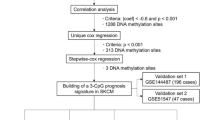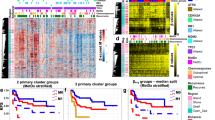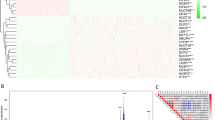Abstract
The human high molecular weight-melanoma associated antigen (HMW-MAA) is a membrane-bound chondroitin sulfate proteoglycan that is variably expressed in a high percentage of melanoma cell lines and tumors. Since the mechanism(s) regulating HMW-MAA expression has(ve) not been defined, in this study, we have examined whether promoter DNA methylation regulates the level of HMW-MAA expression. In melanoma cell lines, the level of HMW-MAA mRNA and protein expression is coordinately regulated, implicating a transcriptional control mechanism. Consistent with a role for regulation by DNA methylation, we have found that a dense CpG island flanks the human HMW-MAA gene transcriptional start site. Methylation-specific PCR and sodium bisulfite DNA sequencing analyses indicate that the HMW-MAA promoter is heavily methylated in melanoma cell lines, melanoma lesions and normal lymphocytes that do not express HMW-MAA; in contrast, the HMW-MAA promoter is not methylated in melanoma cell lines and tumors that express this antigen. In addition, HMW-MAA expression is markedly induced in HMW-MAA-negative melanoma cell lines by incubation with the DNA methyltransferase inhibitor 5-aza-2′-deoxycytidine. In summary, our results establish DNA methylation as a key regulator of HMW-MAA expression by human melanoma cells. This information represents a useful background to optimize immunotherapeutic strategies targeting HMW-MAA.
This is a preview of subscription content, access via your institution
Access options
Subscribe to this journal
Receive 50 print issues and online access
$259.00 per year
only $5.18 per issue
Buy this article
- Purchase on Springer Link
- Instant access to full article PDF
Prices may be subject to local taxes which are calculated during checkout











Similar content being viewed by others
Accession codes
Abbreviations
- ALM:
-
acral lentiginous melanoma
- Anti-id:
-
anti-idiotypic
- BSA:
-
bovine serum albumin
- DAC:
-
5-aza-2′-deoxycytidine
- ERK1/2:
-
extracellular signal-regulated protein kinases 1 and 2
- FAK:
-
focal adhesion kinase
- HMW-MAA:
-
high molecular weight-melanoma associated antigen
- IHC:
-
immunohistochemical
- LMM:
-
lentigo maligna melanoma
- mAb:
-
monoclonal antibody
- MSP:
-
methylation-specific polymerase chain reaction
- qRT-PCR:
-
quantitative real-time PCR
- RT-PCR:
-
reverse transcription-PCR
- SSM:
-
superficial spreading melanomas
References
Bachman KE, Park BH, Rhee I, Rajagopalan H, Herman JG, Baylin SB et al. (2003). Cancer Cell 3: 89–95.
Bestor TH . (2003). Ann NY Acad Sci 983: 22–27.
Burg MA, Grako KA, Stallcup WB . (1998). J Cell Physiol 177: 299–312.
Campoli MR, Chang CC, Kageshita T, Wang X, McCarthy JB, Ferrone S . (2004). Crit Rev Immunol 24: 267–296.
Chekenya M, Rooprai HK, Davies D, Levine JM, Butt AM, Pilkington GJ . (1999). Int J Dev Neurosci 17: 421–435.
Ching TT, Maunakea AK, Jun P, Hong C, Zardo G, Pinkel D et al. (2005). Nat Genet 37: 645–651.
Christman JK . (2002). Oncogene 21: 5483–5495.
De Smet C, De Backer O, Faraoni I, Lurquin C, Brasseur F, Boon T . (1996). Proc Natl Acad Sci USA 93: 7149–7153.
Eisenmann KM, McCarthy JB, Simpson MA, Keely PJ, Guan JL, Tachibana K et al. (1999). Nat Cell Biol 1: 507–513.
Fang X, Burg MA, Barritt D, Dahlin-Huppe K, Nishiyama A, Stallcup WB . (1999). Mol Biol Cell 10: 3373–3387.
Frommer M, McDonald LE, Millar DS, Collis CM, Watt F, Grigg GW et al. (1992). Proc Natl Acad Sci USA 89: 1827–1831.
Futscher BW, Oshiro MM, Wozniak RJ, Holtan N, Hanigan CL, Duan H et al. (2002). Nat Genet 31: 175–179.
Gardiner-Garden M, Frommer M . (1987). J Mol Biol 196: 261–282.
Hafner C, Breiteneder H, Ferrone S, Thallinger C, Wagner S, Schmidt WM et al. (2005). Int J Cancer 114: 426–432.
Herman JG, Graff JR, Myohanen S, Nelkin BD, Baylin SB . (1996). Proc Natl Acad Sci USA 93: 9821–9826.
Iida J, Meijne AM, Knutson JR, Furcht LT, McCarthy JB . (1996). Semin Cancer Biol 7: 155–162.
Iida J, Pei D, Kang T, Simpson MA, Herlyn M, Furcht LT et al. (2001). J Biol Chem 276: 18786–18794.
Jones PA, Baylin SB . (2002). Nat Rev Genet 3: 415–428.
Kageshita T, Nakamura T, Yamada M, Kuriya N, Arao T, Ferrone S . (1991). Cancer Res 51: 1726–1732.
Kageshita T, Kuriya N, Ono T, Horikoshi T, Takahashi M, Wong GY et al. (1993). Cancer Res 53: 2830–2833.
Karpf AR, Jones DA . (2002). Oncogene 21: 5496–5503.
Karpf AR, Lasek AW, Ririe TO, Hanks AN, Grossman D, Jones DA . (2004). Mol Pharmacol 65: 18–27.
Kawasaki H, Taira K . (2004). Nature 431: 211–217.
Kusama M, Kageshita T, Chen ZJ, Ferrone S . (1989). J Immunol 143: 3844–3852.
Li LC, Dahiya R . (2002). Bioinformatics 18: 1427–1431.
Liu G, Ying H, Zeng G, Wheeler CJ, Black KL, Yu JS . (2004). Cancer Res 64: 4980–4986.
Mittelman A, Chen ZJ, Yang H, Wong GY, Ferrone S . (1992). Proc Natl Acad Sci USA 89: 466–470.
Mittelman A, Chen ZJ, Liu CC, Hirai S, Ferrone S . (1994). Cancer Res 54: 415–421.
Morris KV, Chan SW, Jacobsen SE, Looney DJ . (2004). Science 305: 1289–1292.
Serrano A, Tanzarella S, Lionello I, Mendez R, Traversari C, Ruiz-Cabello F et al. (2001). Int J Cancer 94: 243–251.
Sigalotti L, Coral S, Nardi G, Spessotto A, Cortini E, Cattarossi I et al. (2002). J Immunother 25: 16–26.
Song F, Smith JF, Kimura MT, Morrow AD, Matsuyama T, Nagase H et al. (2005). Proc Natl Acad Sci USA 102: 3336–3341.
Temponi M, Gold AM, Ferrone S . (1992). Cancer Res 52: 2497–2503.
Weber J, Salgaller M, Samid D, Johnson B, Herlyn M, Lassam N et al. (1994). Cancer Res 54: 1766–1771.
Yang J, Price MA, Neudauer CL, Wilson C, Ferrone S, Xia H et al. (2004). J Cell Biol 165: 881–891.
Acknowledgements
This work was supported by PHS Grants P01 CA89480 and R01 CA105500 awarded by the National Cancer Institute, and by a grant from the Harry J Lloyd Charitable Trust (to SF). ARK acknowledges generous support from the Ralph Wilson Medical Research Foundation, the Roswell Park Alliance Foundation, and the Phi Beta Psi Sorority. We thank Smitha James and Petra Link of the Karpf laboratory for expert technical assistance. We also thank our many collaborators for providing the human melanoma cell lines used in this study.
Author information
Authors and Affiliations
Corresponding author
Rights and permissions
About this article
Cite this article
Luo, W., Wang, X., Kageshita, T. et al. Regulation of high molecular weight-melanoma associated antigen (HMW-MAA) gene expression by promoter DNA methylation in human melanoma cells. Oncogene 25, 2873–2884 (2006). https://doi.org/10.1038/sj.onc.1209319
Received:
Revised:
Accepted:
Published:
Issue Date:
DOI: https://doi.org/10.1038/sj.onc.1209319
Keywords
This article is cited by
-
The regulatory mechanisms of NG2/CSPG4 expression
Cellular & Molecular Biology Letters (2017)
-
Histone deacetylase inhibitors induce TAP, LMP, Tapasin genes and MHC class I antigen presentation by melanoma cells
Cancer Immunology, Immunotherapy (2008)
-
An epigenetic vaccine model active in the prevention and treatment of melanoma
Journal of Translational Medicine (2007)



